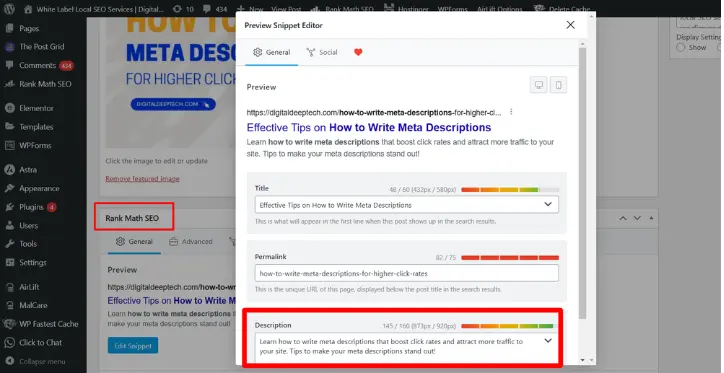How to Write Meta Descriptions for Higher Click Rates

Table of the content
Introduction
A clear and an effective meta description remains one of the most important SEO factor in this hyper-digitally competitive world. Since then, I have known pretty well as a local SEO expert and founder of Digital Deep Tech how a rightly written meta description can immensely contribute to your click through rates (CTR).
In this comprehensive article “How to Write Meta Descriptions for Higher Click Rates”, I am going to lead you through the process step by step guide. We discuss how to improve the CTR by using overall SEO strategy.
Day 17 of the Free SEO Course
Learn advanced strategies, then reach out to get online training to take your skills to the next level!
Why Meta Descriptions Matte
The challenge is to stand out where search results for a single query top thousands. When searching for something related to your contents, your meta description is the first touch. If your meta description is unappealing or irrelevant, you would likely be overlooked in favor of more appealing pages.
Effects of Poor Meta Descriptions
A poor meta description can be really a disaster. Here are three looses:
- Poor CTR: A vague or uninteresting description does not encourage users to click on your link. That may lead to lower CTR. It directly affects your relevance because of which the search engines make an estimate of relevance regarding your content.
- Low Organic Traffic: Missed potential traffic and the potential subsequent conversions every time a visitor avoids your site because the description is weak.
- Brand becomes invisible: If visitors are constantly ignoring your posts, then your brand fades out of mind, and you find it difficult to become authoritative and eventually trustworthy in your niche.
Learn the Consequences
Effects of avoiding meta descriptions are way much more than just a missed click:
Short-term and Long-term Impact
- Higher bounce rates: In case the users feel that your content does not provide what the meta description offered for them, then they will bounce very fast. This will increase your bounce rates and also affect your reputation with search engines.
- Broken Trust and Credibility: A user expects that any information he reads in your meta description is reflected correctly on your page. If his expectations are not met because he feels misled, then what you have done is broken his trust towards your brand.
- Wasting of Resources: Quality writing takes time and resources. Should that quality writing fail to attract visitors because of inappropriate meta descriptions, then what you have invested is wasted.
The Emotional Cost
Sometimes, the frustration level is too high: looking at how other people’s content is doing great and you are trying everything while nothing works. I was there; it hurts to waste efforts. The good news is that this cycle can be broken if you learn the art of writing effective meta descriptions.
How to Write Meta Descriptions That Convert
Step 1: Know the Basics of Meta Descriptions
What a meta description is and how it is used is not known before you start writing interesting meta descriptions for SEO:
- Definition. Meta description is an HTML attribute summarizing the content of a webpage. Meta descriptions are shown in search results beneath the page title in most search engines.
- Purpose: The most important purpose is to convince users to click through to your website by giving them a short, attractive preview of what they’ll probably find.
Step 2: How Long Should a Meta Description Be?
How long should a meta description be?
- Word Count: Meta descriptions should be around 150-160 words, the study shows. It will ensure your description reads fully on most of the search engines without getting cut off.
- Keyword Placement: By chancing on placing your target keyword inside this word count, it can give relevance and visibility to your target keyword
Step 3: The Nitty-Gritty of Writing Good Meta Descriptions
Now that we have the dos, let us get down to the how-to compose good meta descriptions:
- Action-oriented words
Inform your search audience to do something about your website page. Using action words like “discover,” “learn,” or “find out” can make your users click.
- Example: “Discover how to write effective meta descriptions that boost your CTR today!”
- Use Your Focus Keyword
Using your focus keyword, such as “how to write meta descriptions,” on your meta description can drastically increase your visibility in SERPs.
- Example: “Learn how to create click-driving meta descriptions and leverage your SEO now.”
- Unique Selling Points
What’s unique about your content? This is going to be the value you will offer users when they click.
- Example: “Receive practical knowledge on writing meta descriptions that sends users in and traffic your way.”
- Relevance
Make sure your meta description is accurate to what’s on your page. A misleading description can get readers to bounce and harms your credibility.
Step 4: Tactical Tactics for Writing Meta Descriptions
Now that you know what meta descriptions are, let’s jump right into some tactical tactics that you can implement today.
A Step-by-Step Guide
- Find Competitors: Look at how competitors are writing their meta descriptions. This may highlight some best-practice strategies and even give you places in your own descriptions where there might be room for improvement.
- Provide Value: Research on some key takeaways you’d like your meta description to convey: What is it about this content that’s valuable for readers?
- Compose several drafts and drafts of variations: You are free to test different words and calls to action-what really resonates with an audience.
- Monitor CTR: Once you have implemented, make sure to monitor CTR in Google Analytics. Notice which descriptions work better and calibrate from there.
Step 5: How to Change Meta Descriptions on WordPress

Changing meta descriptions is quite easy if you are on WordPress. Here is how you do it:
- Access the Post/Page: Click on the post or page that you intend to edit. Use Yoast or RankMath plugin to easily update meta descriptions, shown in above screenshot.
- Scroll down to SEO Settings: You are likely to find this in any one of the sections for your meta description just below the post editor.
- Description Change: Just write the new meta description that you want to insert inside the given space. Do your best to keep it straightforward and interesting.
- Update Your Page: Just click the update button after saving your changes. Just make sure that everything checks out so that your description is appearing as intended.
Step 6: Checking Meta Descriptions of any Website
There are quite a few ways through which one can check the meta description of any webpage.
- View Page Source: Click the right button on the page and select “View Page Source.” Now you will be able to find the <meta name = “description” content = “>. This is the meta description of that page.
- SEO Tools: Moz, SEMrush, or Ahrefs will give you the meta description data of any page. They’ll let you know how optimized they are.
Step 7: Monitor and Optimize
Always be prepared to update your meta descriptions:
- Periodic Reviews: Review your descriptions periodically to ensure they remain relevant and effective. If changes are happening in the user behavior or search trends, then it is the time to adapt.
- Trend Changes: If the search words or keywords trend is changing, then you should adjust your descriptions to fit in relevance meeting the trends.
Meta Description Important Terms
Knowing key terms will also help you improve the quality of your meta descriptions. A few key terms are:
- CTR: It’s a percentage term that refers to how many of the users clicked on the link after they look at the link in the search result page. The high rate for CTR shows that your meta description is well effective.
- SEO (Search Engine Optimization): This is a range of techniques and processes intended to make you more visible to an engine. Good meta description is part of much much larger strategy of SEO.
- SERP: This is the page returned by a search engine to provide an answer to the question being asked. It is where your meta description will be appearing and thus decides whether people click on your link.
Additional Tips to Write Great Meta Descriptions
To further enhance your meta description skills, here are some tips:
- Avoid Keyword Stuffing: As keywords have become a primary part of the meta description, this alone is enough to make descriptions unnatural and not appealing to the eye of the user.
- Create a Sense of Urgency: Words of urgency – like “limited time only,” “today only,” or even “exclusive” words – provoke an impulsive call to action.
- Use Numbers and Lists: Adding numbers catches the eye and makes content seem more digestible. For example, “5 Tips for Writing Meta Descriptions That Work” will be more exciting than some general statement.
- Personalize When Possible: When possible, use meta description copy to resonate with targeted audience segments. This tells them that you understand what they want.
- Voice: All the written material should be in the brand voice. Consistency is one of the major characteristics of branding.
Let's Discuss Your Project
Get a free one-week consultation and share your vision for digital marketing with us.
Conclusion
Effective writing of meta descriptions is part of the scope for improving the overall level of visibility of your site with an increased click rate. Understanding the logic as to why a meta description is used, knowing how a meta description should be appropriately used, and periodically helping improve it gives you an online footprint that is maximal.
Try using these strategies and fine-tune your meta descriptions. Don’t forget, SEO is a continuous journey, and each click matters. Keep that engagement; keep on learning; and take that digital presence to new heights!
Book your one-on-one appointment here: +91 9780668174 for online SEO training. You must share this topic on your social profiles.
Frequently Asked Questions (FAQs)
1. What is a meta description?
A meta description is a summary of what’s on a page of content and appears in a search result.
2. How many characters should a meta description be?
Ideally it is between 150 and 160 characters.
3. How do I create a meta description for my blog post?
To ensure you are including the keyword, it is often a good idea to get creative with the language as it will likely be imperative for an action-oriented writing, and explain what reader can expect to gain by going to that page of your website.
4. How can I find the meta description of a website?
To check page source or for SEO tools and many other things to come across meta description.
5. Am I able to change meta descriptions WordPress?
Yes; Use the Yoast SEO SEO plugin, then it becomes easy to change your meta descriptions.
6. My meta description is too long, so what happens?
If it is beyond the size of the maximum characters then you will probably end up losing some words over a search engine. Must be between 150 to 160 characters.
7. Should I include keywords in my meta description?
Have keywords that could help a page come up in a search engine.
8. How will I know if my meta description is working?
This can be done with Free SEO tool: Google Analytics; your performance is seen as guidance to the changes you make to your descriptions.
9. How do you write a good meta description?
Use action language while including keywords and reflecting that which is on your page.
10. Can the meta description have an influence on SEO?
While meta descriptions in themselves do not influence rankings, they might improve your click-through rate and, consequently, enhance your SEO performance with time.

About the Author
Deepak Sharma is the founder of Digital Deep Tech and a renowned SEO and digital marketing expert with over a decade of experience. Passionate about helping businesses enhance their online presence, Deepak specializes in creating SEO strategies that drive traffic and generate leads.




